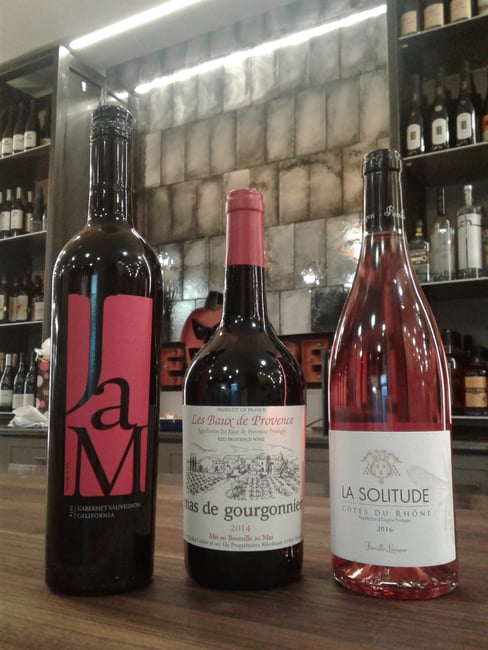Wine pro’s were caught short by American’s Rose rage but regarding the recent popularity of red blends, sommeliers and merchants are saying, “What took you so long?”
Not long ago, as a retailer, I could describe a bottle to an interested customer right up to, “… This is a blend of …” only to be cut short: “A blend? No thanks!”
But in fact, Americans have been drinking blends for decades; they just didn’t know it.
American’s Favorite Blends They Didn’t Know
Italy’s Chianti is a blend, based on the Sangiovese grape. Spain’s Rioja is a blend, based on Tempranillo.
In France, Cotes du Rhone is a blend with a recipe so famous, it has its own shorthand: “GSM” meaning Grenache, Syrah and Mourvedre. Red Bordeaux blends five grapes, in formulae reproduced in vineyards around the world, dubbed simply “the Bordeaux blend.”
Where’s the Beef?
America’s beef against blends began post-Prohibition, as new winemakers laid the foundation of a fledgling industry by emulating the only guide available - the Old World.
Wines were named “Moselle” or “Champagne” for white, “Chianti” or “Burgundy” for red, with no drop of the traditional quality control that makes these styles great.
While hugely popular, boom led to bust, as palates tired of familiar flavors and quality dropped with overplanting. (Your favorite Malbec or Pinot Noir will soon meet the same fate.)
The term “varietal” was born, meaning wine made from one grape variety. (Please note: While the terms are often interchanged, “varietal” is a wine; “variety” is a grape.)
Now, with double-digit sales growth, both winemakers and consumers see the benefits of blending.
Serve the Safety
- Value: Poly-culture is agriculture’s insurance; if frost destroys early-budding varieties, for instance, late-budding varieties may be spared and the farmer’s family will eat that year. Mono-culture regions, such as France’s Burgundy and Napa, build financial protection into higher bottle costs.
- Flavor: Each variety adds its unique flavors to a blend, like a well-seasoned soup. In contrast, how would your favorite recipe taste, seasoned only with salt?
- Marketing: Blends build brand consistency. Varietals depend on fickle Mother Nature and may swing widely in flavor. Blends can be tweaked – some acid-y grapes here, some fruity grapes there – selling the safety of familiar flavors year after year.
Enjoy These Red Blends at The Chopping Block or at Home

While many red blends emulate the “international style” of over-ripe fruit and high alcohol, the wines below are balanced, exciting and easy to enjoy, during your next cooking class or at home.
- JaM Cellars, Cabernet Sauvignon (California, US): Cabernet Sauvignon, Petite Sirah and Zinfandel combine in rich and smooth flavors with a blast of berry-licious flavor and mouthwatering finish.
Global Flavor: JaM Cab with Morroccan Meatballs & Roasted Pork Tenderloin with Dried Fruit Reduction
During our “How to Pair Wine & Food” class (Friday, October 20, Lincoln Square), we’ll mix-and-match JaM Cab with five autumnal dishes, to test the “rules” of wine and food pairing and decide on rules of your own! Register here.
- Mas de Gourgonnier, Les Baux de Provence (Provence, France): Grenache, Cabernet, Syrah and Carignan express ripe fruit, spicy accents and soft texture for a rich sipper and complement to cheeses, meats vegetables and poultry, especially turkey!
Classic Pairing: Mas de Gourgonnier with Charcuterie
Join us for a glass of Mas de Gourgonnier at our Lincoln Square Happy Hour today (Thursday October 12 from 5pm-7pm) or for a complementary glass during our DIY Charcuterie Board class (Saturday October 21, Merchandise Mart). Reserve your spot here.
Rose Year Round
- Domaine de la Solitude, Cotes du Rhone Rose (Rhone Valley, France): This Grenache and Syrah blend is soft, dry and plump with pretty strawberry and watermelon flavors and satisfying finish. A crowd-pleasing pairing for Mediterranean take-out, autumnal appetizers and rich poultry paired with fruit sauce, especially turkey and cranberries!
Enjoy Domaine de la Solitude and five other international wines while learning the foundation of wine knowledge in our most-popular wine class, “How to Bluff Your Way thru Wine” (Tuesday, October 31, Merchandise Mart.) To register, click here.
We look forward to sharing wine with you at The Chopping Block!












